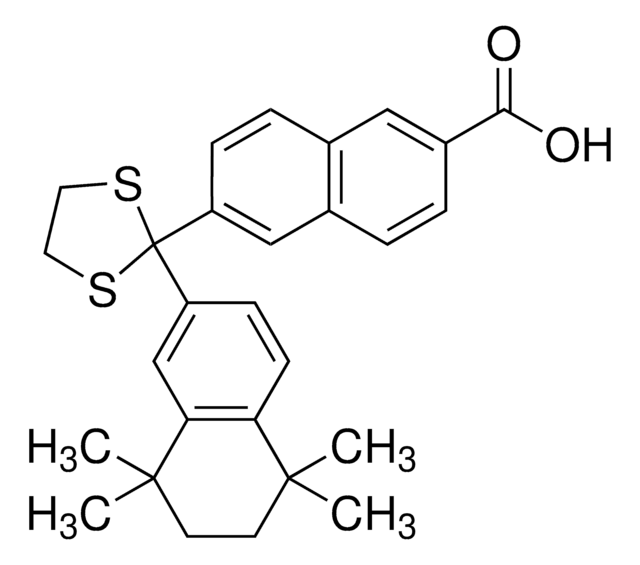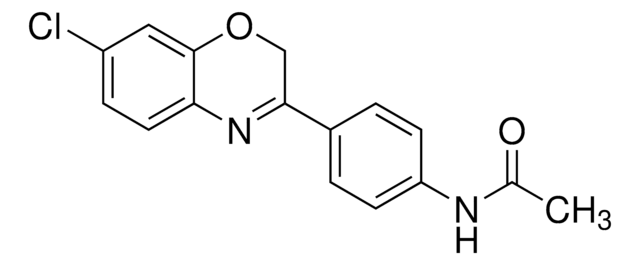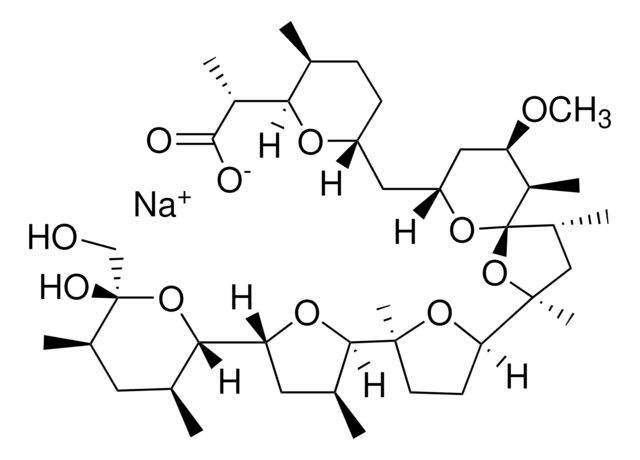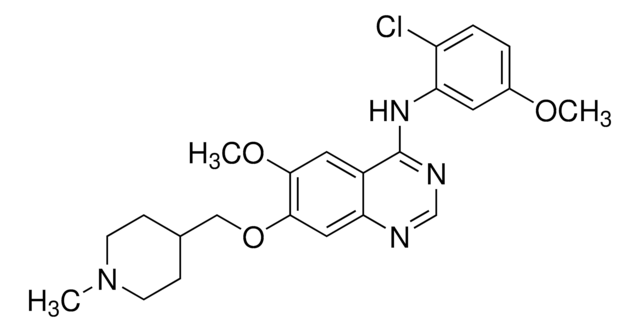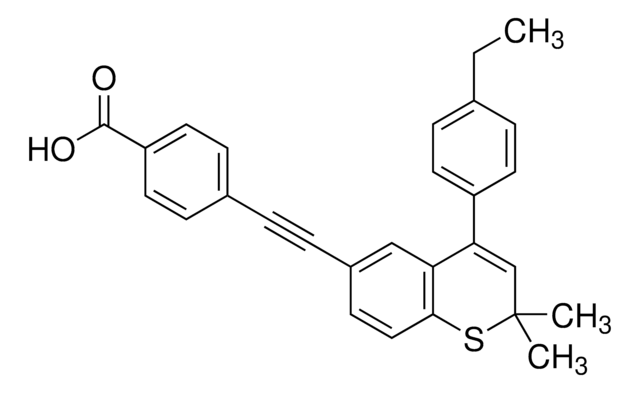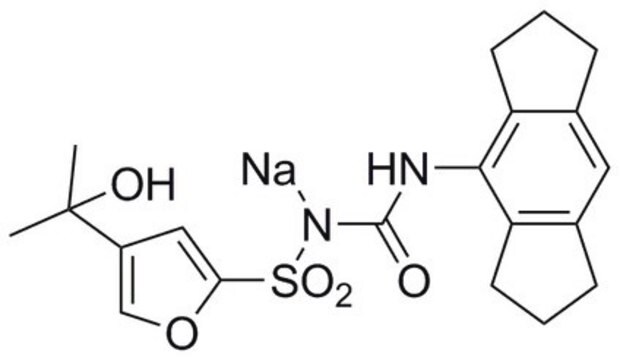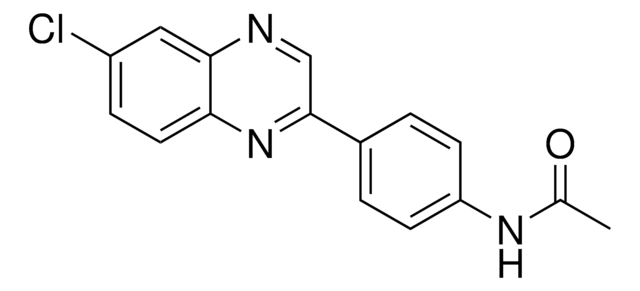SML0921
AR7
≥98% (HPLC)
Synonim(y):
7-Chloro-3-(4-methylphenyl)-2H-1,4-benzoxazine; 7-Chloro-3-p-tolyl-2H-benzo[b][1,4]oxazine, Atypical retinoid 7
Zaloguj sięWyświetlanie cen organizacyjnych i kontraktowych
About This Item
Wzór empiryczny (zapis Hilla):
C15H12ClNO
Numer CAS:
Masa cząsteczkowa:
257.71
Kod UNSPSC:
12352200
NACRES:
NA.77
Polecane produkty
Poziom jakości
Próba
≥98% (HPLC)
Postać
powder
kolor
white to beige
rozpuszczalność
DMSO: 20 mg/mL, clear
temp. przechowywania
2-8°C
Zastosowanie
AR7 has been used:
- as chaperone-mediated autophagy (CMA) activator to study the activity of CMA in rat liver lysosomes
- as a CMA activator to study its effects on expression of DEAD-box helicase 3 X-linked (DDX3X), eukaryotic translation initiation factor 4A1 (EIF4A1), and eukaryotic translation initiation factor 4H (EIF4H) in cancer cells
- to study its effects on synuclein α (SNCA) oligomer levels in mature primary cortical neurons
Działania biochem./fizjol.
AR7 is an atypical retinoic acid receptor α (RARα) antagonist. There is high interest in retinoic acid receptors for cancer and for differentiation studies. Recently, it has been found that signaling through retinoic acid receptor α (RARα) inhibits chaperone-mediated autophagy (CMA). Disruption of RARα signaling has a stimulatory effect on CMA, but can lead to inhibition of macroautophagy. AR7 antagonizes only the CMA inhibitory effect without affecting macroautophagy, allowing the two RARα effects on autophagy to be studied independently.
This page may contain text that has been machine translated.
Hasło ostrzegawcze
Warning
Zwroty wskazujące rodzaj zagrożenia
Zwroty wskazujące środki ostrożności
Klasyfikacja zagrożeń
Aquatic Acute 1 - Aquatic Chronic 1
Kod klasy składowania
11 - Combustible Solids
Klasa zagrożenia wodnego (WGK)
WGK 3
Temperatura zapłonu (°F)
Not applicable
Temperatura zapłonu (°C)
Not applicable
Certyfikaty analizy (CoA)
Poszukaj Certyfikaty analizy (CoA), wpisując numer partii/serii produktów. Numery serii i partii można znaleźć na etykiecie produktu po słowach „seria” lub „partia”.
Masz już ten produkt?
Dokumenty związane z niedawno zakupionymi produktami zostały zamieszczone w Bibliotece dokumentów.
Y R Juste et al.
Methods in molecular biology (Clifton, N.J.), 1880, 703-727 (2019-01-06)
Chaperone-mediated autophagy (CMA) is a selective type of autophagy whereby a specific subset of intracellular proteins is targeted to the lysosome for degradation. These proteins are identified by a chaperone that targets them to lysosomes. There, they are translocated into
Yuqing Hao et al.
Autophagy, 15(9), 1558-1571 (2019-03-02)
Chaperone-mediated autophagy (CMA) is a lysosomal degradation pathway of select soluble proteins. Nearly one-third of the soluble proteins are predicted to be recognized by this pathway, yet only a minor fraction of this proteome has been identified as CMA substrates
Panagiota Mavroeidi et al.
Autophagy, 18(9), 2104-2133 (2022-01-11)
Accumulation of the neuronal protein SNCA/alpha-synuclein and of the oligodendroglial phosphoprotein TPPP/p25A within the glial cytoplasmic inclusions (GCIs) represents the key histophathological hallmark of multiple system atrophy (MSA). Even though the levels/distribution of both oligodendroglial SNCA and TPPP/p25A proteins are
Alba Navarro-Romero et al.
NPJ Parkinson's disease, 8(1), 126-126 (2022-10-07)
Mutations in the GBA gene that encodes the lysosomal enzyme β-glucocerebrosidase (GCase) are a major genetic risk factor for Parkinson's disease (PD). In this study, we generated a set of differentiated and stable human dopaminergic cell lines that express the
Philip Wing-Lok Ho et al.
Autophagy, 16(2), 347-370 (2019-04-16)
Parkinson disease (PD) is an age-related neurodegenerative disorder associated with misfolded SNCA/α-synuclein accumulation in brain. Impaired catabolism of SNCA potentiates formation of its toxic oligomers. LRRK2 (leucine-rich repeat kinase-2) mutations predispose to familial and sporadic PD. Mutant LRRK2 perturbs chaperone-mediated-autophagy
Nasz zespół naukowców ma doświadczenie we wszystkich obszarach badań, w tym w naukach przyrodniczych, materiałoznawstwie, syntezie chemicznej, chromatografii, analityce i wielu innych dziedzinach.
Skontaktuj się z zespołem ds. pomocy technicznej